Unbalanced feet are an epidemic in the horse world. It’s an area where most owners ‘leave it to the professionals’ and don’t give it a second thought. Unfortunately, the professionals aren’t always doing a good job. Those unbalanced feet lead to all sorts of issues; navicular disease, mechanical founder, uneven gaits, sore muscles, fractures, abscesses, quarter cracks, WLD, behavior issues, arthritic changes, sore feet, bruised soles, and so on.
Please take the time to read the following short article on the rehabilitation of the feet of a foundered horse. There are a couple of really important points made in the article that all should take note and understand, as well some excellent pictures that we can use for reference and comparisons, even against non-foundered horses.
“Trim: whether you leave the horse barefoot or apply a hoof boot or shoe, realigning the coffin bone with the hoof capsule is critical to healing.”
“Our goal with trimming a foundered horse is realigning the hoof capsule with the coffin bone.”
If you get nothing else out of this article, understand the following: Those are contradictory statements and it’s unfortunate they were used suggesting an interchangeability. The first is incorrect, but it’s the way most people think horse’s feet work in founder situations; that the coffin bone rotates within the hoof capsule.
It does not.
If the coffin bone were to truly rotate within the hoof capsule, the horse would be in unbearable, excruciating, writhing pain with hoof and leg ‘guts’ falling out of the bottom of the foot and blood squirting everywhere. The hoof would literally be torn to shreds.
What really happens in foundered horses is that the hoof capsule grows unevenly, specifically the heels grow more rapidly than the toe. In more extreme cases the toe stops growing all together. This happens because the heels continue to be supplied by blood and nutrients, while the toe experiences a significant reduction of blood and nutrient supply because of the die off of the laminae. This uneven growth puts further stresses on the inner workings of the hoof and a vicious cycle is born. The x-rays then seem to show a coffin bone that has rotated, but it’s really the hoof capsule that has rotated via its uneven growth. That means the coffin bone is always ‘right’. Trim the hoof capsule balanced and voila!
As a point of reference to help you see that the coffin bone hasn’t rotated but rather the hoof capsule, look at the joint of P1 (coffin bone) and P2 (short pastern). If the coffin bone had truly rotated within the hoof capsule that joint would have been ‘closed’ in the first radiograph, having pushed the navicular bone closer to the back of P2, and then progressively become more ‘open’, having dropped the navicular bone further from the back of P2. Instead, everything stays the same throughout.
When looking at the subject’s feet..
…the first thing most people will notice is the dished toes. But the first thing you should notice is the heels. Just as we should be riding the horse back to front, we should be examining and trimming feet heel to toe (back to front). The heels of this horse are way too long, in part due to typical founder growth. Those long heels run forward and push the toe (and breakover point) forward. Because the toe doesn’t grow an equal amount and is weakened by dying/dead laminae, accelerating the stretching of the white line in a foundered horse, the toe also begins to turn up, unlike in a typical low heel, long toe (LHLT) situation.
Here is a classic LHLT foot. The heel on this horse is just as long as (arguably even longer) than the foundered horse’s heel in the article, but because the toe of the foot isn’t compromised by dying/dead laminae it remains structurally strong and doesn’t dish. Instead, the heel compresses and collapses under the stress. Both horses suffer from equally distorted foot imbalances.
Below is an x-ray of a LHLT foot. Note that the coffin bone also looks rotated just as in the foundered horse.
From the bottom we see that the foundered hooves have become oval shaped instead of round. (Back feet are less round than front feet, naturally.) The heels (red) are clearly not located at the widest part of the frog (yellow) as they should be, and instead are significantly forward.
And on the LHLT foot, which has also become elongated and therefore oval in shape:
Seven months later the foundered hooves are round, heels and breakover point pulled back, frogs considerably healthier and more substantial, and white line stretching significantly reduced, showing nice tightness at the toe.
Your horse’s feet don’t have to be this bad for it to be suffering from an imbalance, and there are lateral imbalances that are just as crippling to the horse. It’s time owners paid more attention to their horse’s feet and learned what’s good to see and what’s not. Like all things, some individuals are more sensitive and vulnerable to imbalances, showing lameness at the slightest, while still others can go years with foot imbalances before suddenly succumbing. Good leg and body conformation can often ‘absorb’ the stresses of imbalanced feet, but not forever. The weakest link eventually gives out.
One final note; feet are so important to the horse’s long term health and soundness that poor genetic feet should be a deal breaker for breeders and buyers. Including but not limited to; small feet, flat soles, clubbed or shelly feet. It does not matter if a horse has super sonic track speed or can jump the moon if its feet can’t function as intended, comfortably propelling it forward and absorbing the concussion of landings. It’s of no benefit to the horses to pass on, serving only to weaken the species and make man look selfish and stupid.

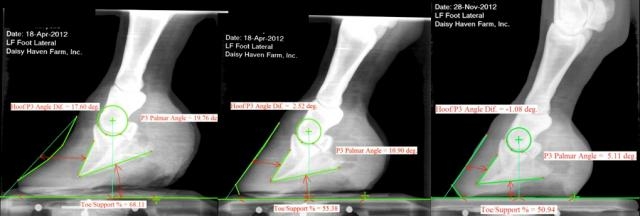



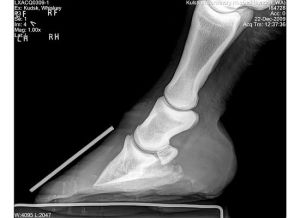
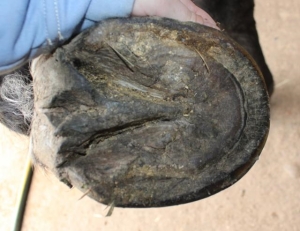
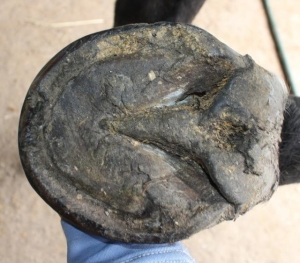
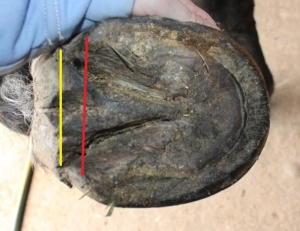
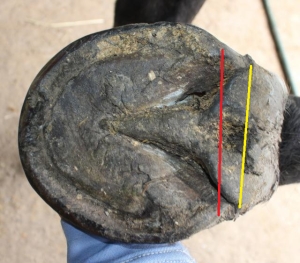
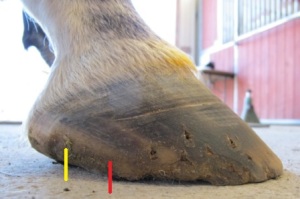
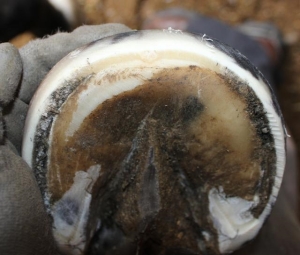
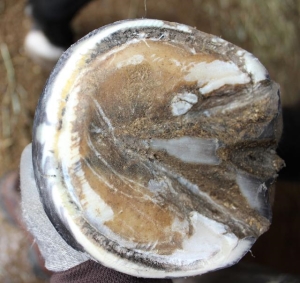
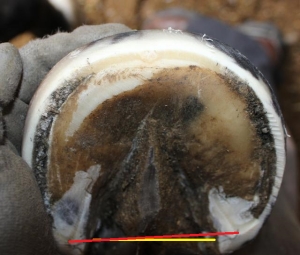

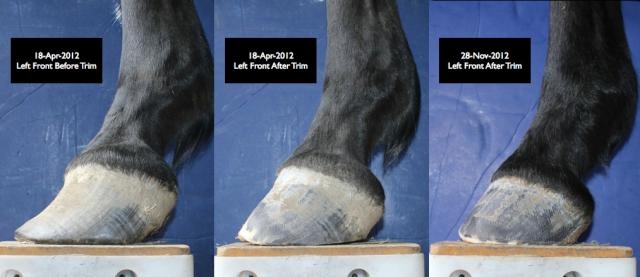
Thank you so much for this post – super interesting and helpful to see it explained so well.
Thanks, this is a difficult lesson for me, the horse I have now had shoes for years and nothing but trouble, went barefoot fine, and now is in boots. Sifting the internet for information often leads to confusion for me.
Sometimes taking shoes off will allow the horse to wear its feet back into balance, particularly if the horse had good leg and foot conformation naturally.
It was interesting. The shoes never seemed to last the 4 weeks, one or another would always fall off, and he had really crumbly hooves. I was told that he would never go barefoot, and if I tried it would have taken a year to find out. As a last resort, I had them pulled and for 2 months, started hand walking a short way down the trail, then short rides, then back to our usual routine. His hooves are now quite hard, and I am now using boots on the front. A year ago he started getting sore, vet and farrier are stumped, the soreness is slight, and probably just because he is so old.
Anyway the point of all this is that you just need to listen to the horse.
Thank you for this!
Yay!
I always say that of course the coffin bone is rotated – it rotates with every step the horse takes – it’s half of a joint, for Heaven’s sake! The capsule has rotated in relation to the coffin bone!
This is a great learning tool to cross post to others. I’ve seen so many bad feet the past few months, not just neglected by lack of trimming, but poor quality trims and shoeings. One would think this only happens in the backyard horses but I’ve seen some high end stables with ‘navicular in the making’ feet that appear to be the norm. Most have way too much heel and the heels are terribly contracted, the hoof taking on an elongated, pinched shape. Add in wedge pads here and there and it can’t get much worse.
I have 2 LHLT horses that barely make a 6 week schedule and I encourage my farrier to trim back more than he would if I didn’t nag. If the heels aren’t back to the widest part of the frog, their feet are overgrown 3 weeks post trim. This is compounded when the horse is shod and the hoof cannot self trim between farrier visits.
The last couple of years there has been a big changeover in work from farriers to a couple of barefoot trimmers and the use of boots for trail/stoney ground rides. The most recent convert was a woman who bought a mare for trail a year ago, like the horse as it was calm, willing, would do anything, but had cronic nagging soundess issues. She had paid vet for tests, drugs, etc, her farrier for expensive corrective shoes and finally said she would give the horse away to someone that needed a companion animal, she was tired of fooling with it. The common friend of ours who runs the barn, said he would try to balance her feet as he was convinced that was the majority of the problem. He’d had a three year running battle when he couldn’t keep any of his cutting horses sound, and finally started doing the feet himself and pulling the shoes. In about eight weeks of correct trimming (he did a trim that was not radical but did address some of the worst imbalances, then he would do slight adjustments every week to 10 days to make sure he would keep leveling foot without making the change too radical) mare was mostly sound. Now at about four months, she’s moving great even on harder ground. The lady no longer wants to give her mare away.
My last farrier caused 2 of my horses to have mechanical laminitis. When I went to the big lameness vet in the area, he said that he makes much of his money from bad farriers. Most of the farriers in this area leave WAY too much toe. Even with x-rays in front of them, they are too conservative about pulling the toe back. If the farrier was paying the vet bills and feeding my horses while they were laid up, and providing me with another horse to ride, that would be one thing (kind of), but I’m stuck with all of the cost and down time. I finally found a guy who will work with my vets and me and my horses have been sound. As a horse owner, I was forced into learning more about feet and shoeing than I really wanted to because of the waste of money and time. I don’t think that anyone likes being critical of their farrier or firing them, but we have to do what’s right for our horses first.
As other people have hinted at, I’m also becoming a barefoot convert. “My” mare was a QH (although she did have good sized feet for her body) and she was always barefoot. We galloped the hills together with out ever a lame step. Her real owner did nothing but a little rasping here and there and never bothered with any fancy supplements or creams. That horse had rock solid, wonderful feet all year round. Now if I’m with a horse with shoes I’m paranoid they’re throwing them. I’m not used to that clanky clopping on the driveway!
Good feet are a 100% must for me, I just don’t care to deal with poor feet, so I don’t buy a horse that doesn’t have good feet. Then I am very lucky to have an excellent farrier, so the feet stay that way. I’m sort of a barefoot convert; I’ve been able to keep my last couple of horses (having selected them for good feet) barefoot under normal circumstances. But I show jumpers on grass and I’m not willing to forgo the extra traction of corks when faced with wet grass. So I compromise and shoe competitive horses for the show season, and then pull the shoes after the last outdoor show.
Semantics, but yes the hoof wall can definitely be ‘peeled away’ from the coffin bone when the laminae are damaged, and in acute founder that process can happen right the way down the hoof wall in a matter of days, resulting in an immediate degree of ‘rotation’. Which is a very good reason why one of the first things you should think about (trimming-wise) with a laminitic horse is transferring the pressure off the wall as much as possible, especially at the toe, to reduce those leverage forces until the laminae have had time to heal somewhat.
Yes, you should use feet as a criteria when looking at a horse, but immediately dismissing a horse for ‘bad feet’ may lead to you missing out on a good animal. The thing is to identify WHY the horse has ‘bad feet’ and if it can be remedied. Some things are beyond help (or at least, unable to be improved sufficiently in the time frame you have); others can be fixed relatively quickly if you know what needs to be done and actually DO IT – much of what needs to be done is on a daily basis by the owner, not every now and then by a professional that comes in.
I’m very familiar with ‘bad TB feet’ and have converted a large number of them to ‘good feet’ (or at least, much better feet) with proper hoof balance and attention to diet. Any time you see a horse with flared, flat soled feet, you should immediately be thinking that the horse is quite likely to have low grade laminitis (yes, even hard keeper TB’s!) – deal with that, and often the feet will improve dramatically.
Genetics is often blamed for poor feet, but all too often it’s a small part of the overall issue – the care the horse has received over it’s life time is a much bigger factor. Sadly though, if the issues have been present for long enough, there may be permanent internal changes that will limit the extent to which the feet can recover. And of course, correcting bad feet may take months or even longer, so you have to be able to give it as long as it takes if you take on a horse with an issue like that.
In terms of breeding stock, no you definitely don’t want to perpetuate crappy feet – but you still have to be able to differentiate between genetics and environment. I used to trim for a small-time TB breeder that had chronic hoof issues with all her horses. When I started trimming, I went through not only hoof care, but diet and other factors. She immediately changed her way of feeding as well as the trimming, and whadda-ya-know, not only did the current horses all improve drastically, but the following crops of youngsters all had ‘great’ feet despite being the exact same family lines they’d had so much trouble with in the past (and were then able to withstand poor shoeing in the racing stables that much better because they had a reasonable underlying structure to begin with).
It’s depressing the number of horses I see that have crappy feet due entirely to the care they are receiving, whilst the owners believe that they have the very best care possible. They can’t see that they are paying someone (or paying for feed) that is CAUSING their horse to be miserable and uncomfortable. Just because the vet, farrier or feed merchant is a nice person and can talk a line of bullshit doesn’t mean they actually know diddly-squat about proper hoof balance (and how to deal with pathologies effectively) or nutrition!
Of course, while the diet can often be changed very quickly, if you’ve got hoof pathology and weakness it may take a long time to get the feet sorted out. It’s not just a case of changing the trim and everything is fine – you have to grow out damage and encourage weak areas to strengthen, and to do that you may not be able to put the feet immediately into ‘good’ balance, even if there is enough foot to trim it there. A classic problem with very forward toes is bringing the breakover point back too rapidly and overloading the rear of the foot before it is able to deal with that level of concussive forces, thus making the horse even more heel sore and perpetuating the underlying problems – in cases like that, I’ll bring the BP back slowly over the course of several trims to give the rear of the foot time to adjust. The LTLH foot you showed above is a classic example – the heel bulbs are almost non-existent and you’d have to make haste slowly or set the horse back even more.
I guess the key thing here is to never take anyone’s work as gospel, regardless of their qualifications or job. If you’re unsure about anything, ask around, do your own research, and if needed, find someone else that will do a better job (or learn to do it yourself).
Kahurangi
New Zealand
Please elaborate on the feed issue.
Hi TR20,
Feed is an integral part of hoof health. Diet is the major factor in many hoof pathologies, either because important building blocks aren’t supplied in the first place; they are supplied but can’t be used because an excess or lack of other building blocks exists; or there are negative elements supplied that overload the system and cause damage.
Signs of hoof related feed issues can include ‘sub-clinical’ laminitis (flared walls, flat soles, stretched white lines) through to full blown clinical laminitis; chronic thrush problems, thin weak shelly walls that crack and split, thin soles, and so on. Sadly, many of these things are often not recognised as diet related (or the wrong diet issue is diagnosed), so the root problem doesn’t get addressed and the symptoms are never really overcome despite all the other efforts made of trimming, topical treatments etc.
So you have to not only supply sufficient quality building blocks (amino acids, fats, vitamins and minerals) in the right amount and balance to be able to grow the strongest possible foot, you also have to avoid deleterious nutritional elements that weaken it (excess sugars that cause inflammation, imbalanced minerals that cause inflammation and/or prevent correct usage of other minerals etc). That may mean changing what you’re feeding and/or how it is given, cutting back access to sugary grass, and/or adding in specific extra items to balance out other excesses (e.g. bumping up specific minerals to balance out excesses of other minerals).
You might think that the answer is to make sure you give a ‘top quality’ prepared feed, but sadly they are often far from actually being top quality – loaded with inflammatory factors, and missing very important ones. Once you begin to delve into nutrition, you start to discover that many of those products are a big part of the problem, rather than a solution. This goes for mineral supplements too – many are surprisingly imbalanced, especially when you start to look at what is provided via typical grazing and hay.
The TB breeder I mentioned above was spending tens of thousands a year on ‘the best’ feed which was actually causing most of her problems – she changed products, cut her feed bill by more than half, and the feet have been 1000% better ever since. Add to that less vet bills, and better racing times, and it goes to show that that ‘premium’ feed was causing a great deal of damage not just to the horses but to her pocket too.
And just to make it even more confusing, an overall diet that is seemingly perfect for one horse may cause problems for another near-identical horse in a similar situation, so even once you’ve got a good overall picture of things you may still need to tweak things on a case by case basis. Lucerne / alfalfa is a good example – it’s perfect for some horses, yet can cause major problems for others. I can’t feed even a cup of it to one of my TB’s or he instantly gets sub-clinical laminitis and his feet fall apart, and yet my friend who keeps her TB at my place has no problems feeding a big scoop daily. The rest of the TB’s here can tolerate varying amounts.
Nutrition and how it impacts hoof and general health is obviously a HUGE subject, and not something I can really cover here – if you’re interested in it, then I really suggest taking some of Dr Kellon’s courses (http://www.drkellon.com/ – and she has a 2 for 1 special on for Christmas!), and maybe joining some groups like Wholehorsehealth (https://groups.yahoo.com/neo/groups/wholehorsehealth/info) where nutrition is regularly discussed.
Please however, don’t expect your local feed merchant to give you even half-way decent advice – all too often their knowledge is woefully bad or even downright dangerous. I once had two separate feed stores (including one that formulated and produced their own feeds) give me advice that would have literally caused the death of the horse in question within weeks if I’d done what they suggested, even though I had given them all the specifics of the health issues I was dealing with. Luckily I knew enough to avoid that, but I wonder how many other horses are in poor health or dead because of that sort of advice 😦
Kahurangi
New Zealand
Adding: like human finger nails can show signs of nutrient imbalances so can horse’s hooves.
Also, just like humans, individual horses are more prone to systemic/digestive issues that will affect their feet. Such as some horses are more sensitive to sugars in their diets than others. I like to call this type of situation the ‘constitution’ of the horse.
Horses with good genetics all around tend to maintain good feet even if they aren’t being fed the best feed or the best balance of nutrients.
Thanks for the insight. How and what to feed my horse has been kind of a steep learning curve for me.
Great article! I had a lovely pony mare with excellent feet and a year after I sold her I saw in pictures that her heels looked very low. I sent ‘before’ pics to the new owner and hope she heeded my warning about them. While I often look at feet and have an opinion as to whether they look ‘balanced’ or not, perhaps you could elaborate on what exactly makes the hoof balanced?
X-rays are the most accurate way to determine balance, however, you can develop your eye enough to ‘see’ the coffin bone within the hoof, just as you can develop your eye to see the skeleton beneath the muscle.
Paying close attention to the frog will also tell about the balance of the foot – that’s for another discussion with different pictures.
There is an angle range for front and back feet of which the majority of horses should fall within, and outside of those ranges at either end are almost surely unbalanced feet. And the ranges are rather small, just a few degrees.
There’s also the way the horse stands that lets you know how balanced the feet are or are not. The horse should be able to easily stand square, not leaning back on its heels or forward on its toes, and should be ‘in the ground’ rather than on top of it.
Know that when the feet are unbalanced that all the bones above are also slightly out of alignment. Those misalignments change how the horse moves and carries itself. You can also develop your eye to see those movement differences.
‘Frowning’ coronet bands are another telltale sign of unbalanced feet.
Just as it’s difficult to find pictures of good riding, it’s difficult to find pictures of balanced hooves. 😦
Thanks! Yes it amazes me how hard it is to find really good pictures demonstrating things being done right!
So when I look at my horses feet, I should see a horse that stands looking comfortable. That the feet look round (hind feet slightly oval) and that the hoof slope resembles that of the pastern. Also looking at the frog it should be nice and wide and ‘healthy looking’, not shriveled or too narrow for the hoof. So I’ll add to that the ‘straight’ coronet. I do think my farrier does a great job and that the horses look comfortable on their feet even when standing on hard ground.
No, a pastern continuing on the angle of the feet is not necessarily an indicator of balanced feet. But if there’s a clear break in the angle, then they are obviously unbalanced feet. Take another look at the three series picture at the end of the article showing the outside of the feet, pastern, fetlock and up the cannon bone a bit. Notice how the pastern tries very hard to stay in alignment with the unbalanced feet via the closing or opening of the fetlock joint. The cannon bone is very clearly in front of the vertical in the first photo and then moves closer to vertical the better the foot balance gets. The pastern joints themselves don’t have a lot of range of motion, but the fetlock does. When you see breaking angles within the pastern, you’re way beyond a simple hoof capsule imbalance. Make sense?
Wow yes! I hadn’t noticed how the entire leg posture changes visually while trying to compensate!
Right, that’s one of the hardest things to understand: unbalanced feet causes misalignment up the ENTIRE leg AND INTO the body. It’ll affect the shoulder, the neck, the back, the loin etc… Even a little bit of an imbalance, and you need only think of it as wearing two different shoes. They could even be two running shoes, but with a bit of a different thickness of sole, or a different amount of arch in the insole. How long do you think you could go through life before your knees, hips, lower back and shoulders start to succumb? How long until you do permanent damage? That’s what it’s like for a horse with unbalanced feet.
Yes! Yes! Yes! Oh, de leg bone connected to de hip bone… et cetera!
I would that every young equestrian was made to memorize this with their hands over their little hearts just like the Pledge of Allegiance!
I can speak to problems stemming from letting the feet get out of balance just a little, unfortunately.
Not the founder problem usually associated with imbalance, more about lateral imbalance than heel to toe.
The Paint Mare was in a new environment over the summer, harder, dryer, more coarse sand and gravel. I had hoped this would toughen up her bare feet, which have always been OK on most surfaces. But instead, partly because she was late for a trim, she ended up getting sole/wall separation in the outside quarters, worse on the rear feet, where she pronates (walks on the outside) a little anyhow. It took a while to notice this, as sand packed in and the size of the gap was only evident after she’d had it scoured out by walking on gravel.The separation has been moderately painful for her, especially when she got stones jammed up there (I started packing the gaps when I realized this). I don’t think she would have developed this at all in her usual environment, which is hogfuel and soft sand.
We are still dealing with this now, four months later (she is back in her usual world). It doesn’t seem to be full-on white line disease (there’s not a lot of decay or deterioration), and it doesn’t seem to be laminitic, more a mechanical separation that is worsened when gravel gets up the gap and grinds in. My farrier has finally decided to be less conservative, and took off a scary amount of compromised wall, which seems to be the right move. The horse didn’t go dead lame, as we’d feared, and now there is nothing to continue wrenching away or trap stones.
BTW, about founder: my farrier (professionally trained, but specializing in barefoot) has said that a horse with a well balanced foot probably won’t founder even if it has a laminitic episode; long heels and toe pre-dispose to founder.
Another attribute to note is the digital cushion of the hoof. The digital cushion is an integral part of hoof mechanism, providing cushion of the coffin/navicular bones as the horse steps down and the frog bears weight. http://horsehoofhelp.com/wp-content/uploads/2011/10/LongToeDC.jpg This is a good cross section showing a poorly developed vs well developed cushion. A horse landing toe first will be under-developed. A frown shaped coronary band is often coupled with a nearly non-existent cushion. On flat ground or traveling downhill, a horse should land heel first never toe/heel landing.
Can a digital cushion regenerate or grow back? On-line barefoot information says that it can. But I was recently at a hoof/lower leg clinic/anatomy/dissection session given by a good local vet who is also a farrier and a barefoot advocate. He seemed to think the cushion wasn’t something that could develop, and he said he would see an underdeveloped cushion as a red flag in a pre-purchase exam.
That’s an excellent question. Many body organs are quite regenerative, others not so much and their recovery is very much linked to the percentage and type of damage. I’ll try and get some answers from my sources.
Hi Paint Mare,
Absolutely, the digital cushion and to a lesser extent the lateral cartilages can be strengthened and thickened – I’ve done this myself on numerous occasions. I’ve got 2 TB’s in my paddocks right now that have more than twice the thickness of DC that they did when they first came to me, and instead of feeling like soft squidgy sponge they feel like firm rubber. The entire rear of the foot is vastly stronger even though all they’ve had is (occasionally irregular) hoof care and no additional exercise beyond wandering the paddocks.
That said though, it is a long slow process that can be set back fairly easily, and it will ONLY happen when the horse is using the heels correctly and the foot is able to function properly. So that means that any and ALL reasons for heel discomfort have to be addressed appropriately – poor trimming, poor diet, body imbalances, frog infections, etc. [With extreme pathology you may not be able to achieve sufficient heel comfort, of course.]
The faster the horse starts to use the heel correctly, the better, which is where appropriate use of hoof protection (boots and pads, glue-on’s, etc) may help jump-start the process, since it can be easy to accidentally overload very weak tissues and then cause the horse to avoid using the heels even more – it may be a very fine line between not enough stimulation and too much. If the horse still won’t use the heels despite what seems to be reasonable hoof care and protection, you may need to dig a bit deeper to find what else is causing him to avoid using them – thrush? Upper body issues causing postural changes? Unsuspected internal damage in the hoof? And so on. Until you identify and treat those underlying issues (if that is possible), you won’t achieve a proper heel first landing.
Even in a healthy foot, the digital cushion takes a long time to develop – it will remain fairly soft and spongy until the horse is five or so, since it needs a great deal of correct stimulation to reach it’s maximum strength. So regenerating (or strengthening it for the first time) may take years to achieve (and will only begin to occur once you’ve addressed whatever heel issues exist), and depending on how the foot has developed it may never achieve the full strength that it might otherwise have in a more optimal situation. Ditto with the lateral cartilages – you may thicken them somewhat, but if they are thin and folded over and the internal sling hasn’t developed, you’ll never get them to be as robust as they could have been under more ideal circumstances.
In most cases though, if the horse had a semi-reasonable start to life and the DC and LC’s aren’t completely pathetic, you’ve got a good change of being able to strengthen them sufficiently for the horse to withstand most peoples expected workload (especially if hoof protection is used as needed). And during that strengthening process, you will likely still be able to use the horse to do most if not all that you wish (that’s what boots are for ), so it’s not like you have to plan on 2 years of rehab with no riding. However, for a horse intended for heavy competition, you really do want a decent heel region to begin with or you may find yourself fighting a downhill battle.
So like any other hoof issue, you need to figure out how bad it is, if you and your various equine professionals have the skills to treat the issues, and if they can be addressed within the time frame you’ve got (i.e. can you afford to spend X months on rehab before using the horse as you plan).
Kahurangi
New Zealand
If anyone can point to a reputable online resource for educating oneself on correct trimming, balanced feet and how to spot problems (and their symptoms), I’d love it.
The trouble with finding good internet info is that everyone claims that they have the answers, and unfortunately, some simply don’t. What sounds plausible at first glance may turn out to be horrifyingly bad advice when further investigated 😦 Equally, you may find vehement opposition to certain ideas and concepts (especially barefoot v’s shoes), often without any actual consideration of the underlying principles and evidence.
And just to make things trickier, what works great for one horse may not work well for another, for variety of reasons. So even once you’ve got a basic understanding of correct balance and trimming principles, you still need to be able to factor in a few if’s, but’s and maybe’s.
Some websites I like include http://www.hopeforsoundness.com/cms/articles/how-hoof-form-relates-to-hoof-function.html, http://www.hoofrehab.com/ and http://www.daisyhavenfarm.com/ (already mentioned in this blog).
If you really want to get in-depth on the subject, then you can’t go far wrong with Pete Ramey’s book “Care and Rehabilitation of the Equine Foot” – if you don’t want to spend the $$ yourself, ask your local library to get it in for you. This is my ‘hoof bible’ 🙂
Kahurangi
New Zealand
http://www.barefoothorse.com/ I learned a lot on this site, quality photos and multiple case studies.